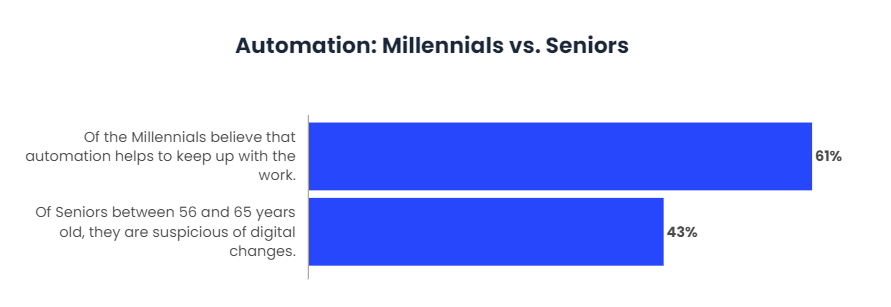Are EXTech a new indispensable element for automation?

As the world of technology moves rapidly, business leaders are being forced to provide the tools necessary to enable their employees to have better digital experiences in their work environment. However, given today’s large technology marketplace, it is difficult to predict which technology will be useful and which will not.
That need translates into the term Employee Experience (EX), which is essentially the concept of creating a satisfying digital environment for employees that in turn reflects the goal of a company’s Customer Experience (CX). However, the beginning of each one is different since the EX begins with the recruitment and retention of the best talents by facilitating a comprehensive work experience that addresses personal, professional and social values.
With 77% of people owning smartphones, most digital workplaces run on applications that employees can access from their mobile devices. These applications constantly add functionality to train middle managers and their associates. Applications such as shift management, on-boarding, communication, training and many other features that employers use to put responsibility in the hands of their associates also enable remote working and ultimately the digital workplace.
In response to this demand, vendors are building or upgrading their software and platforms to accommodate these trends, the primary one being remote work and providing employees with access to work applications through their mobile devices.
Employee Experience Technologies
Employee Experience Technologies (EXTech) are a diverse combination of solutions created to improve and influence organizational culture and employee status. Behavioral economics and positive psychology are the central focus to maximize the employee experience in line with the organization’s values and business objectives.
Until now, this concept, which was originally known as “worker participation platforms”, has appeared in various disciplines, such as gambling, social responsibility, welfare, industry-specific WFM solutions and social recognition tools.
However, the situation has changed recently and today’s dynamic market for technology and human resource services is responding in a clear and concise way. As providers of human capital management (HCM) software continue to expand and acquire new capabilities, emerging technologies such as Artificial Intelligence (AI), Machine Learning and HR chatbot solutions are flourishing. However, it all comes down to a new side of business automation, focused primarily on improving operational efficiency and employee experience.
Innovation is happening in all areas of HR technology, from leading software-as-a-service (SaaS) providers, to employee experience technologies, performance and feedback tools, to talent acquisition solutions, e-learning technologies, wellness platforms, and even payroll services.
For example, an integrated, interactive SaaS platform provides companies with the data-driven, actionable information needed to effectively manage employee engagement. Thus encouraging recognition of talent, positive behavior, and achievement. In addition, these platforms integrate a gamification section allowing for an effective feedback system, which helps companies build greater trust, cultivate leadership and include their team in business decisions.
However, for all steps towards even greater automation to be successful, there must be a strong and positive correlation between business impact and employee experience.
What benefits will companies get from EXTech?
Motivating and empowering employees is a key task today. Improving the employee experience drives motivation and commitment, thus adding value to business performance and results that lead to an agile culture in the organization.
To this end, a commitment to automate the areas surrounding employees will further support the Employee Value Proposition (EVP) with the aim of improving business performance by better integrating the brand and the objectives of the Employee Experience organization.
There are a number of key values that demonstrate the benefits:
- Greater efficiency, both for the employee and for executives.
The best thing about automating employee resources is that it facilitates the development of all company tasks. This is reflected for example in the speed of action, the timelines benefit when employees can get the documents they need and quickly complete any action in a short time, for example.
On the other hand, the company gains transparency and accuracy when it comes to management: maintaining compliance, ensuring commitment and freeing up critical human resource tasks for more strategic initiatives.
- Fail-safe processes and risk mitigation
Due to the extension of the working life of workers, in the near future there will be situations where more than five generations will have to live together in the same working environment. No matter how diligent the employee is, the ‘human error factor’ continues to exist, and sooner or later, it will negatively impact the business plan.
As more and more millennials begin their careers, it is imperative for companies to stay in sync with the latest technology as part of their value proposition.
It was recently found that 61% of 18-25 year olds expect business automation software to help them keep up with the times compared to 43% of 56-65 year olds who are wary of these digital changes.

- Stay in line with compliance protocols.
The regulatory landscape has changed enormously over the years. And in this situation, an automation program can make strategies to keep employees satisfied easier. In addition, it will help companies keep up with any laws or regulations that are promoted in the future.
- Improved employee satisfaction rates.
At a time when employee participation is key to business success, an automated program will help workers submit their documents faster, simplifying their lives and completing their tasks more quickly. This will not only increase motivation, but also encourage people to focus on critical business objectives and boost productivity.
These are some of the most common reasons why companies in general look to EXTech as a key component in improving their organization’s profit strategy.
How can companies implement it?
For successful design and optimisation of the EXTech, it is important to have a good overview of the overall experience of the employees from start to finish.
A journey map is a great tool that visually describes an employee’s journey as they strive to achieve a goal. It represents a timeline of the employee’s experience and key points of contact; what the employee feels, thinks and does; as well as weaknesses and opportunities.
Employee journey mapping can provide much-needed clarity and help identify areas where the company should prioritize its employee experience efforts, based on all the moments that are generated from a broader or more comprehensive view.
If employee experience is important to an organization, then they must ensure that it provides the right value to workers, and they must also be concerned with the memorable moments that are important to the workforce.
Creating an inspiring experience for employees is not just about providing additional benefits, perks and using modern technologies. The important thing is to motivate and engage employees and help them improve in their work through innovative technologies and features. For example:
- Social networking for internal use: Social networking platforms can actually increase productivity and collaboration, when used internally of course. Social technologies can increase the productivity of interaction workers by 20% to 25% due to improved productivity and collaboration.
- Intranet / Google-like information database: Most employees spend nearly 20% of their work week searching for internal information or locating colleagues who can help with specific tasks. In response to this problem, an employee search intranet can make it easier for employees to find and share information about almost any part of their work or workspace without having to make a new request to the IT department.
- Mobile technology: With the rise of remote working and increasingly global businesses, the ability to work from a phone or tablet, not just to check email, is more important than ever. 51% of IT leaders agree that by 2025, the most successful companies will have shifted from developing computers as a primary tool to mobile.
When implemented strategically, these tools can reduce the amount of infrastructure IT must manage. This can have a huge impact on a positive employee experience.
Conclusions
Automation is fundamentally reshaping the way society lives and works. Thanks to continued advances in technologies such as AI and data analysis, it is expected that in the future virtually all systems with which people interact on a regular basis will incorporate automated functionality so that mundane processes are eliminated and everyone can focus on more strategic activities.
Organizations can expect not only that their employees will be up to date with their work, but that, over time, the software will be automated to the extent that it is fully adapted to the needs of the users. Companies that take full advantage of the benefits automation offers will be the winners in the new economy.
EXTech is not only seen as a goal to be achieved, but offers a strong positive impact that will translate into ultimate success for growth and retention of employees and companies.


